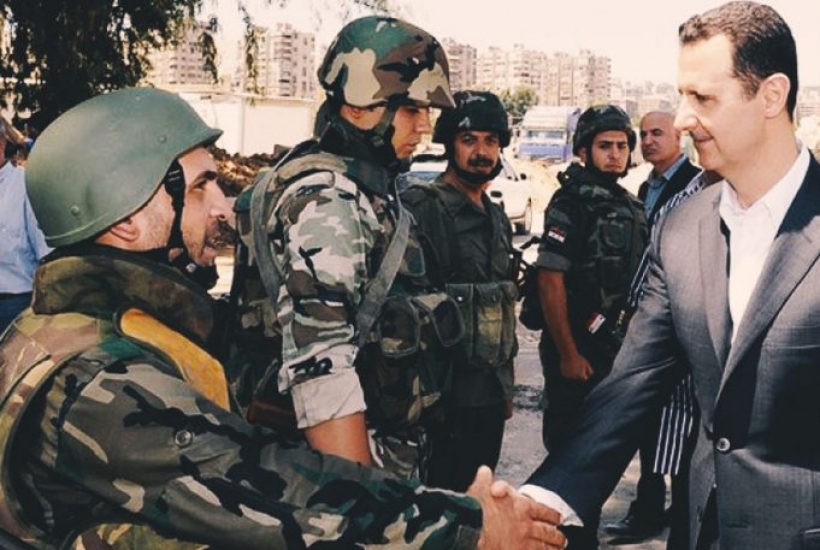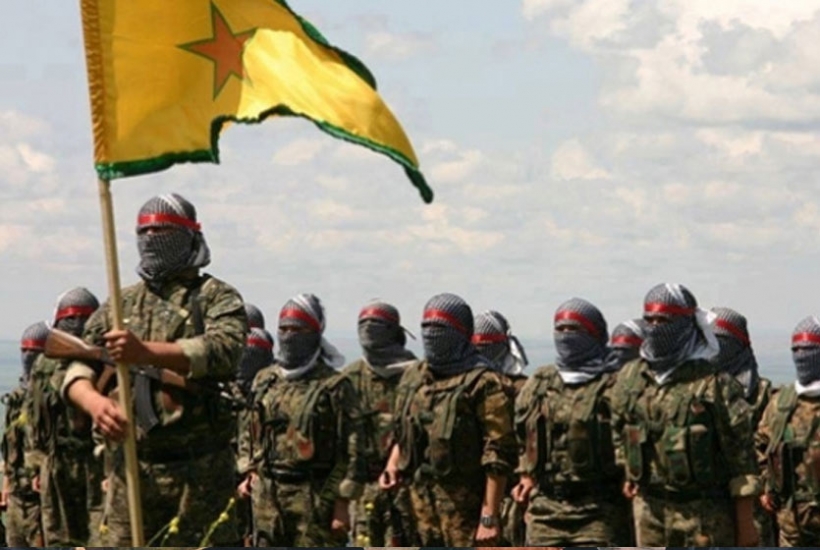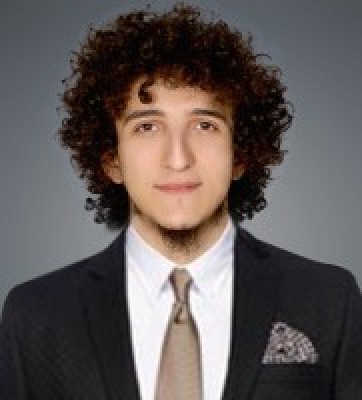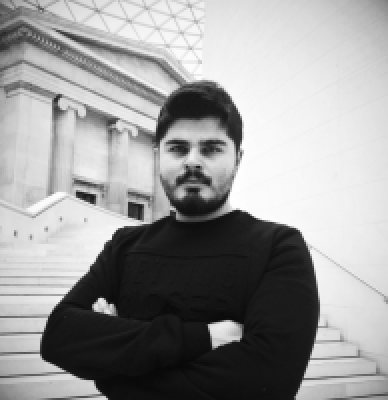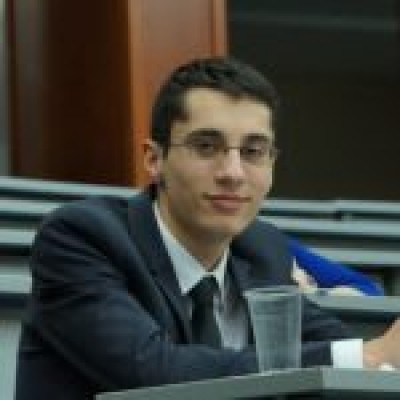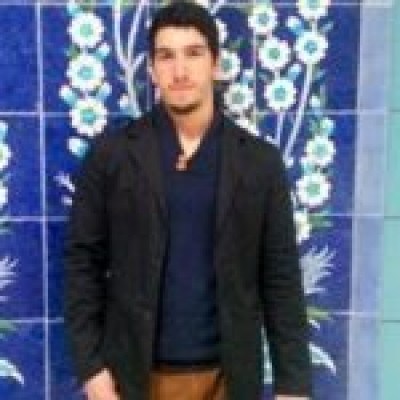Analysis
The Syrian Army: Limited Capacity and Fragmented Structure Ömer Behram Özdemir
Syrian Arab Army: Limited Capacity and Fragmented Structure
After having lost swathes of territory in the key regions of Aleppo and Damascus during the first half of the civil war, the Syrian Regime has been able to regain these areas in 2018 only after highly-destructive military incursions resulting in thousands of civilian casualties, and still only with ground and air support from Iran-backed militias and the Russian Air Force, respectively. While these successes are taken as evidence that the “regime forces” are set to be the victors of the 7-years-running Syrian Civil War, severe losses and erosion incurred by regime forces have raised legitimate doubts of its sustainability. Iranian support after 2013 in the face of rising regime losses as well as the introduction of Russian air support after the 2015 loss of Idlib has afforded the Syrian Arab Army (SAA) enough breathing room to recuperate and reclaim some of the territory it had lost. Despite this, there have been arguments that SAA is no longer a serious military force by itself, lacking the capacity to wrest control of the rest of the country in its entirety with its allies unwilling to incur the high cost of committing to this goal.
The Erosion of the Army and its Main Hurdles
Even relatively conservative Russian assessments place the military might of SAA between 70K to 80K in manpowe[1]r, down from 2011 estimates at the onset of the war at roughly 220K[2]. Aside from over 60K KIA[3], this decline owes itself to widespread desertion and defection of soldiers previously loyal to the Assad Regime. Syria and radical organizations expert Charles Lister notes that the Russians estimate the maximum number of their ally’s trained, disciplined, and effective forces to be roughly 20 thousand.[4] That SAA is deteriorating in terms of quality as well as quantity is the common view of many experts. Anton Mardasov argues that SAA no longer possesses the usual hierarchical structure normally found in regular armed forces. Instead, Mardasov speaks of the ascendency of individual elite units such as the Tiger Forces, Republican Guards, Deir al Qalamoun, and Saif al Mahdi among other forces in the army.[5] These elite units, which were established from among other elements within the army at the initiative of the regime, have become semi-autonomous in terms of firepower and funding. According to Mardasov, the latest successes attributed to the regime were in fact more reflective of the power of its allies than the effectiveness of its own military.
Security expert and retired Colonel Mikhail Khodarenok contends that not only do the Regime Forces lack the capability to successfully execute military operations on their own, but that given its current state, it would be easier to disband and rebuild SAA from scratch, rather than institute corrective reforms. Khodarenok argues that SAA has become fragmented within itself, due to its overstretch among approximately 2000 fortified checkpoints across the country.[6] Aside from these limitations, another important issue is that of the rising strength of pro-regime militias, also known as the “Shabiha”. These militia groups, which were mobilized during the early phases of civil unrest of the Syrian conflict in order to be used as a coercive force against demonstrators, became a secondary military body upon which the regime relied. Initially recruiting from individuals and groups with criminal backgrounds, the majority of these groups comprise of Alawite fighters, along with some Christian and Sunni groups.[7] As paramilitary organizations, the Shabiha lack the relative discipline and regulation of the regular military. Thus, it is likely that their rise will result in further erosion of the regular army’s hierarchical structure, handicapping its already limited military capacity. Throughout this process of attrition in the Syrian military command, it has been the Russians who have been the most active in mitigating the situation. Russia, along with Iran and Hezbollah, played a leading role in the establishment of the 5th Assault Corps. The success of this multi-sectarian force based on volunteer recruitment would position Russia as the chief actor in reshaping the Syrian security forces while at the same time consolidating Moscow’s future role in the country.[8] It has been the aforementioned deficiencies of the Regime’s security institutions that provided the circumstances necessary for such Russian action. The 5th Assault Corps has been stationed most notably on the periphery of the T4 airbase on the Homs front, as well as Hama, the Deir ez Zor countryside, and Ghouta, though it has not thus far played a decisive role on the battlefield.
SAA: Inadequate when Unaided
The ineffectiveness of SAA becomes apparent when one compares its casualties and performance in confrontations where it enjoys the support of its Russian, IRGC, Iraqi, Afghan, and Lebanese (Hezbollah) allies with those confrontations where it does not. The regime’s inability to claim similar dominance against the US-supported SDF in and around Deir ez Zor where it lacked such support, as that which it claimed in Aleppo is a clear example of such a contrast. The implication is that a SAA dependent on foreign military assistance from the Russian Air Force and Iranian-backed militias will not be able to reestablish itself as the sole authority over the US-backed SDF in the foreseeable future, as it is not seen as a decisive force either by its allies, or its adversaries. As such, it can be seen that such overtures by some analysts and politicians claiming that Turkey, “should negotiate with Assad in order to put an end to the YPG/PKK presence in Northern Syria through cooperation of the Turkish Armed Forces and SAA”, are thus unsubstantiated as they are based on the premise that the latter is an effective actor capable of functioning independent of outside assistance.
In the case of Idlib, the regime lost control of the district in 2015 due to both logistical advantages of the opposition forces in such proximity to the Turkish border, as well as limited Russian and Iranian support for the regime. At the end of the course of a few months during which the regime lost strategic points including Idlib city, Jisr ash Shugur, Ariha, and Abu Zuhur, Bashar al Assad announced for the first time that SAA was under a shortage of soldiers and that the available resources would henceforth be concentrated on the most strategic targets.[9] In the period following this statement, Russia began its campaign to directly and intensively intervene in the Syrian conflict in order to sustain the regime. Illustrative of the effect of Moscow’s intervention, the fall of Ghouta to SAA was only possible with heightened Russian air support, despite a long-running siege of the enclave.
Data on the SAA and its hitherto performance makes these basic realities clear: SAA is not capable of acting as a standalone force and in its current undisciplined state, is more akin to an army/gang hybrid than a regular military. The resultant cracks in its power and deviation from the qualities of a regular army have made it dependent on foreign assistance in the execution of successful military operations. This has brought Russia to a nearly definitive position in the formulation of Syria’s security strategy after the second half of 2015. When these circumstances are taken into consideration, it can be seen that the critical factor in the analysis of future engagements of SAA will not be its own strength, but the degree of air and command support it receives from Russia and land support from Iran in terms of IRGC presence and Iranian-backed militias.[10] The reality of which the regime’s partners are aware is that the SAA is an ineffective and costly ally. Thus, we can see that when Turkish officials pursue policy on Northern Syria, they opt to solve the issue with the actual decision-making actors, namely Russia and Iran, rather than with the Syrian Regime, which is ineffectual at this point. It is apparent that this deficiency of the SAA has played a major role in the regime’s transformation into a passive actor under the domination of both Russia and Iran.
Footnotes:
[1] Kirill Semenov, The Syrian Armed Forces Seven Years into the Conflict: From a Regular Army to Volunteer Corps, Russian Council, Mayıs 2017.
[2] Joseph Holliday, The Syrian Army: Doctrinal Order of Battle, ISW, 2013, s.5.
[3] Syria war has killed more than 350,000 in 7 years: monitor, AFP, Mart 2018.
[4] Written Testimony of Charles Lister to the United States House Committee on Foreign Affairs April 27, 2017 Hearing on “Syria After the Missile Strikes: Policy Options”, Link: http://docs.house.gov/meetings/FA/FA00/20170427/105890/HHRG-115-FA00-Wstate-ListerC-20170427.pdf , Access Date: 28 Mart 2018.
[5] Anton Mardasov ve Kirill Semenov, Assad’s Army and Intelligence Services: Feudalization or Structurization?, Russian Council, Mart 2018.
[6] Here’s why Assad’s army can’t win the war in Syria, CITEAM, Eylül 2016.
[7] For the thread of Tobias Schneider : https://twitter.com/tobiaschneider/status/765609696162115585 , Access Date: 1 Nisan 2018
[8] Ruslan Mamedov, The Fifth Assault Corps. Back to Order in Syria?, Russian Council, Haziran 2017.
[9] Esad: Ordumuz asker sıkıntısı çekiyor, BBC Türkçe, Temmuz 2015.
[10] Ömer Behram Özdemir, Rejim yanlısı Şii Milisler’in profilleri ve motivasyonları, Suriye Gündemi, Aralık 2017.
The Strategic Importance of Sinjar in the Fight Against the PKK/PYD Emrah Kekilli
The Strategic Importance of Sinjar in the Fight Against the PKK/PYD
While Turkey has cleansed Afrin from terrorist elements with the Operation Olive Branch and continues its fight against the PKK’s extensions in the north of Syria, it continues to fight against the PKK’s extensions in northern Iraq and Sinjar especially. Turkey has, with the words of its president Erdoğan, made clear that it will not tolerate any PKK presence in Sinjar as Sinjar is seen as a priority target in its fight against the PKK in northern Iraq. This is due to Sinjar being the main connection in the PKK’s terrorist lengthy Iraq-Syria corridor. The Fishabur border crossing on the Iraqi-Syrian border with its proximity and connection to Sinjar is especially seen as a logistics and supply hub between Qandil and the Syrian cantons.
The terrorist organization has, as in Syria, taken advantage of the possibilities it was offered by the terrorist organization of Daesh, and gained ground in Sinjar. The terrorist Daesh had entered Sinjar in 2014, while the KDP peshmerga withdrew from Sinjar to Zummar. The PKK has with the help of the US taken advantage of the fragile situation in terms of security and settled in Sinjar. To make its existence in Sinjar permanent, the PKK has chosen to organize the regional Yezidi population along its own ideological lines. While it has tried to clinch its political and civil presence in Sinjar with the Shengal Founders Council, the Women’s Freedom Movement and the Martyrs Afrin Academy, it has constructed and settled communication centers, ammunition depots and command centers on the Sinjar mountain. When we consider the Mahmur camp of the PKK that lies in between Qandil and Sinjar, we can see that the PKK is trying to establish a line of control that carries the potential to exploit the people of northern Iraq and force them into the inner parts of Syria.
The presence of the PKK is not only disturbing Turkey but also the Kurdish Regional Government as the KDP-backed Rojova peshmerga carried out a military operation on Sinjar which was welcomed by Turkey in March 2017. However, the US has internalized a strategy that incorporates supporting the PKK and its extensions and thus pressured the KDP into conceding in favor of the PKK as the US used the excuse that it was “harming the fight against Daesh”. Additionally, the central government of Iraq chose to support and pay the salaries of Sinjar’s Yazidis, who have connections with the PKK, to try to balance the KRG’s influence in the region. Moreover, the Gorran movement and PUK, which are in opposition to the KDP in the KRG, have internalized a rhetoric that favors the PKK in the tensions between the KDP and the PKK.
With the Euphrates Shield Operation, Turkey has made clear it is acting according to a new strategy it adopted in its fight against terrorism. As Turkey saw that its desired outcome was not realized in the fight between the Rojova peshmerga and the PKK, Turkey chose to conduct airstrikes against the PKK’s presence in Sinjar-Karachok. Turkey’s actions have shown that it will make game-changing moves in the region in line with its own national security and regional stability and that it will be an effective player that creates new realities on the ground that other players will need to accept.
Preventive Intervention against Terror
In Syria and Iraq especially, as in the Middle East the security sector becomes more and more hybrid, the lines between state and non-state actors are becoming more and more obscure and terrorist organizations are gaining ground, Turkey has internalized a security strategy that is centered around preventive intervention. In light of this, Turkey executes military operations against sources of terrorism in northern Syria and Iraq. Its tactical moves in the forms of military operations and incursions that are interconnected and successive in order are elements of the execution of a grand strategy. The “preventive intervention” strategy of Turkey includes the Euphrates Shield Operation (ESO), the airstrikes in Sinjar and Karachok in April 2017, rural operations against the PKK within the borders of Turkey, the Operation Olive Branch, the hints at an upcoming operation targeting Sinjar and the airstrikes against the terror camps of Zap, Havasin and Hamere to the north of Qandil, in northeastern Iraq. Turkey has shown it is not refraining from using the principle of the right of self defence in a new engagement rhetoric as an answer to cross-border threats.
Turkey executes fast tactical moves along the framework of its strategy that internalizes our country’s and the regions stability in its multidimensional and local, regional and global fight against terrorist organizations like Daesh and the PKK. Turkey has destroyed terrorism at its source with the Euphrates Shield Operation against the terrorist Daesh in between August 2016 and March 2017. After the success of the Euphrates Shield Operation, the TAF on the 25th of April conducted airstrikes against terrorists on the Sinjar Mountain in northern Iraq and Karachok in northern Syria, hitting 20 targets with the aim of breaking the Syrian-Iraqi connection of the PKK. With the same objectives in mind Turkey has crushed PKK elements in its rural countryside and broken the terror corridor of Karachok-Malikiyah-Cizre and Nusaybin that extended into Turkey itself. Hence, Turkey has tackled the PKK’s terror corridor in Syria, the horizontal Iraqi-Syrian terror corridor, the vertical terror corridor of Iraq-Syria-Turkey and terrorist extensions in Turkey itself, targeting them individually but as a result as a whole too.
With the Operation Olive Branch, Afrin has been cleansed from PKK elements. The operation is certain to have implications for the PKK’s presence in Iraq. Turkey has signaled for an operation targeting Sinjar but at the same time conducts airstrikes against the PKK’s camps of Zap, Havasin and Hamere in northeastern Iraq. In other words, Turkey has dealt a major blow to the PKK’s western Syrian part of its terror corridor with the Operation Olive Branch as the PKK tries to construct a terror corridor along Turkey’s southern borders. With the Sinjar operation the aim is to prevent the fluidity of terror between Iraq and Syria. At the same time, by targeting the terrorist camps in northeastern Iraq, the aim is to incapacitate the PKK’s ease of operations and limit them to Qandil.
Intervention into Sinjar and Conjunctural Possibilities
With the Operation Olive Branch, Afrin is cleansed from PKK elements and the local and regional balances are tipped in Turkey’s favor; this has led to the US making concessions regarding the PKK. Turkey, by keeping the question of Sinjar on the political agenda, has shown it will not refrain from repeating its resolve in the fight against terror in northern Syria also in northern Iraq. When we look at Turkey’s insistent behavior in relation to the balances of power in Iraq, we see that cleansing Sinjar from terror is now more possible than it was back in 2017. With the rapprochement between Ankara and Baghdad triggered by the independence referendum in the KRG, Baghdad is now warmer to Turkey’s interests in Sinjar. However, we need to wait for the outcome of the national elections in Iraq on the 12th of May to foresee how any strategy on cooperation in the fight against terror will take shape. The dispatching of troops to Sinjar by the Baghdad government may be read as determination in counter terrorism in Sinjar. The US has seen Turkey’s resolve in counter terrorism in Afrin and has been forced to take a step back, against the PKK’s interests. This is why it will take a softer stance regarding Sinjar compared to the past. The KRG has gotten into a deep political, economic and diplomatic crisis after the independence referendum, which is why it will refrain from coming head to head with Turkey. When all of this is considered, by the summer, the conditions will be ripe for the Sinjar operation.
Turkey besides exerting its hard power capabilities, makes diplomatic moves accordingly to them. By making evident that the PKK in Sinjar is also a problem for Iraq, Turkey aims to get Iraq on its side as seen with Turkish officials visiting Iraq at the highest levels. Foreign Minister Çavuşoğlu visited Iraq in January 2018 and drew attention to the question of Sinjar and counterterrorism in northern Iraq. Chief of Staff Hulusi Akar visited Iraq in March 2018, where border security and counterterrorism were discussed after bilateral military ties gained momentum.
Turkey also makes clear that it understands the Baghdad government’s focus on “national sovereignty” when it comes to Turkey’s intervention into Sinjar. President Erdoğan’s words convey this clearly: “If you can take care of this, take care of it. If you cannot, we will enter Sinjar overnight and cleanse it from the PKK. If we are friends, and brothers, you will grant us the necessary ease when it comes to it.” Ankara, with this statement, conveys the message that Baghdad needs to do something about Sinjar, and Turkey will judge this accordingly to the military capabilities of the Baghdad government and that Turkey will not stand idly by if the PKK’s presence continues.
Separation of Al-Qaeda Elements Within HTS
Separation of Al-Qaeda Elements Within HTS
The current status between Hay’at Tahrir al-Sham and al-Qaida (AQ) loyalists in northern Syria remains a hotly debated topic.
After the Syrian uprising turned to arms in 2012, one of the militant opposition factions that emerged was Jabhat al-Nusrah, it announced its presence in January 23 and was quickly suspected of having close ties with al-Qaida. In 10th of December later that year, they were designated by the US as a foreign terrorist organization acting as a front of al-Qaida in Iraq. This turned out to be correct, for in April 2013 the then acting head of al-Qaida in Iraq, going under the name The Islamic State of Iraq, Abu Bakr al-Baghdadi announced that they had formed Jabhat al-Nusrah and would now merge it into their new group The Islamic State of Iraq and al-Sham (ISIS).
Acting quickly to save his organization, Nusra’s leader Abu Muhammad al-Jawlani (Ahmad al-Shara’) declared his direct allegiance to al-Qaida, instead of his previous one that went via al-Qaida in Iraq. With the time passing and the US-led coalition in getting involved in Syria in 2014 targeting ISIS and Jabhat al-Nusrah due to its al-Qaida ties, in addition to the Russian pro-regime military intervention in 2015 targeting the Syrian opposition as a whole, the armed opposition felt the need more than ever to unite militarily and politically.
Jabhat al-Nusrah supported the call of unity with the other armed factions, but what stopped it from taking place was the insistence of the other groups that al-Nusrah break its ties with al-Qaida as to not cause the blacklisting of the entire armed opposition.
In July 2016, al-Nusra announced its break of allegiance to al-Qaida and rebranded under the name “The Front for al-Shams Liberation”, Jabhat Fath al-Sham (JFS). JFS formation was to be a prelude to what happened in January 2017, when JFS merged with several other Syrian opposition factions and established a grand coalition titled Hay’at Tahrir al-Sham (HTS). This resulted in the agitation of many members of al-Nusra and then JFS who were still loyal to al-Qaida and felt that JFS break of allegiance was not legitimate, leading to the gradual defections of high ranking individuals and even entire battalions.Some analysts claim that most of the schism between them are overblown and very likely a ploy to legitimize HTS on an international level and let them show their distancing from AQ[1], not to mention this still being the current view of the U.S. State Department[2], whilst others take the more apparent view of the front and back arguments between the two sides as an evidence of a clear organizational split between them two, likening their relationship status with the split AQ had with ISIS, what was first a media tactic to relieve the other side of AQ’s bad branding, later turned into a reality to the point of no return.[3]
Nevertheless, unless one has access to classified intelligence or secret correspondence that shows whatever split between HTS and AQ is just a front and not real, one can only try to gather as much public information available on the issue and analyze its veracity.
The history of how then al-Qaida affiliated Jabhat al-Nusrah publicly broke allegiance with al-Qaida has been detailed elsewhere, as well as some of the public statements [4] from the quarreling sides [5] on the legitimacy of the split [6] and if it was sanctioned or not.
The latest development in the conflict after senior al-Qaida loyalists were arrested in November 27 and later released two weeks afterwards [7], is the attempted reach of an agreement between HTS and al-Qaida loyalists who still reject the HTS formation and the split from the AQ central command to end the feud.
In the 6th of January, reports emerged from HTS and al-Qaida aligned individuals that an agreement had been finalized between HTS leader Abu Muhammad al-Jawlani (Ahmad al-Shara’) and the acting head of al-Qaida in Syria Abu Hummam al-Suri (also known as Faruq al-Shami, real name Samir Hijazi). The one presiding over the agreement was an al-Qaida council member named Abu Abdul-Karim al-Masri.
The deal was met with outrage by many al-Qaida members and supporters since they viewed it as caving in to HTS dominance and effectively ending any sort of independency of al-Qaida in Syria.
The agreement (which still hasn’t been officially released but a partial summary of it was leaked by a HTS jurist) was finalized after several meetings stated as follows:
The backlash
On January 8th, Abu Hummam acknowledged on his telegram channel that he had signed under the agreement to “ward off the shedding of the mujahidins blood and for the greater good of the Syrian arena”.
But he added that “some of the students of knowledge looked over the agreed points and they found some islamically objectionable matters, thus I’ve decided to refer the issue back to the agreed upon mediation committee.”
The next day senior HTS jurist Abdul-Rahim Atun criticized Abu Hummam’s decision to end the agreement, saying that they were surprised that the other party decided to null 16 of the 16 agreed points, effectively invalidating the whole agreement.
He continued with saying Abu Hummam said he would still abide by the agreement, but that he couldn’t enforce it since most of his group rejected it.
Atun followed with chiding the al-Qaida loyalists for not following what their representative and leader Abu Hummam agreed upon, and that they are now guilty of the main point of disagreement between al-Qaida and HTS, which is the alleged breaking of an agreement. (HTS and Atun has always maintained that they broke their allegiance with al-Qaida with the permission of the then al-Qaida deputy leader Abul-Khayr due to the absence of al-Qaida leader Zawahiri for over 2 years, something that al-Qaida insist still didn’t legitimize it.).
Atun also pointed out unnamed individuals within al-Qaida in Syria, saying they “don’t care for the general benefits and the path which they lead corrupts rather than rectify the arena.” The unnamed individuals are most likely Abu Julaybib al-Urduni (Iyad al-Tabousi), Sami al-Uraydi, and Abu Khadija al-Urduni. The three are all from Jordan and previously held senior positions within Jabhat al-Nusrah until its break with al-Qaida, leading them to publicly rebuke the decision and causing internal turmoil within HTS ranks.
He ends with an attempt to ease the schism and affirm their solid adherence to islamic rulership and continuation of jihad (something leading al-Qaida loyalists have tried disparage them of), emphasizing that they have no animosity with the al-Qaida loyalists in Syria overall, nor any islamic or ideological objections, rather their criticism is for a certain group of individuals that continuously tries to ruin any reconciliation.
A few days later, two of the senior al-Qaida loyalists commented on the now canceled agreement. First was Sari Shihab, also known as Abu Khallad, who outright rejected the agreement, while the second (Abu Julaybib) added that the entire al-Qaida leadership council in Syria rejected it as well.
For now, it seems any sort of settlement has ended up in stasis, with the al-Qaida loyalists waiting for the decision on it from al-Qaida’s Central Command or Zawahiri himself, additionally a decree from the previously established mediation committee [9], if they ever manage to come to a conclusion.
Conclusion
While it’s easy to dismiss the signed peace agreement by HTS and AQ and its subsequential break as just another chapter of intra-jihadist squabble, it could be seen as an important part of the history between HTS and AQ. Just as Atun pointed out, the fact that one of the main objections al-Qaida has with HTS is what they see as an illegitimate one-sided break of an agreement, which now al-Qaida itself would be bluntly guilty of.
This agreement, or rather the break of it, will remain a point of conflict between the two sides unless they manage to resolve it, something that for the time being looks very slim.
Footnotes
[1] https://www.thenational.ae/opinion/comment/jabhat-al-nusra-and-al-qaeda-the-riddle-the-ruse-and-the-reality-1.672221
[2] https://www.state.gov/r/pa/prs/ps/2017/05/270779.htm
[3] https://ctc.usma.edu/al-qaida-lost-control-syrian-affiliate-inside-story/
[4] http://www.jihadica.com/abandoning-al-qaida/
[5] http://www.jihadica.com/what-we-learned-from-sami-al-uraydis-testimony-concerning-abu-abdullah-al-shami/
[6] https://al-maqalaat.com/2017/12/01/7/
[7] https://kyleorton1991.wordpress.com/2017/11/28/former-al-qaeda-in-syria-branch-arrests-members-of-al-qaeda-in-syria/
[8] Also known as Jund al-Aqsa, a former jihadist Syrian opposition faction that shared much of ISIS ideology, which led to them clashing with other rebels and eventually, HTS itself, leading to their official dissolvement.
[9] https://twitter.com/IbnNabih1/status/923127782233735169
SDF Spokesman Tells About The USA-PKK Relations in Syria
Report / Suriye Gündemi
Talal Silo, the spokesman of the Syrian Democratic Forces (SDF), has made important statements to the Anadolu Agency, after he fled towards Turkey. According to Silo, the SDF is controlled by the Kurdish terrorist organization PKK, and it is known to US officials. Silo confessed that the PKK is controlling the arms given to the SDF. Talal Silo’s statements are a high-level testimony and confession. Especially the statements about irregularity, falsified signatures and name ‚games‘ realized as a result of McGurk’s directive are important.
Silo said that he went to Afrin at the beginning of August 2015 and participated in the structuring of the FSA-inspired militia Jaysh al Thuwwar. The process was led by PKK regional director Hacı Ahmet Hudro. “Ebu Ali Berad was at the head of the Arabs, Selah Çebbo at the head of the Kurds. I was responsible for the Turkmens. I worked under the management of Jaysh al Thuwwar. But the decision-maker was Hudro (PKK). Then they told me to join SDF. The first meeting for it was with PKK region manager Sahin Cilo.” he said.
Silo made some noteworthy comments about the establishment of the SDF. The first meeting of the so-called SDF was held on 15 October 2015, but the foundation was declared as October 10. The reason for this irregularity was, the US has carried out arms shipments on 10 October in the Hasakah region, Silo informed. This date announcement was particularly requested by PKK’s Sahin Cilo to justify weapon shipments between 10 and 15 October. According to Silo US fostered the formation of a SDF umbrella, because arming YPG would lead to problems in an international level.
Silo said that the foundation of the SDF was other then assumed realized at the request of the USA: “It’s just a name. It’s nothing else. We get everything including the salary from the YPG. The main reason for the establishment of the SDF is the United States. The US administration wanted to give the Kurds weapons. The SDF is only one theater. It’s referring to the union of the components, but it‘s nothing like that. The US gave the leadership to Kurds and the PKK”.
He also criticized the SDF for deals with ISIS and that it forces civilians to migrate, destroying houses and not giving peace to people living in refugee camps.
Silo said that weapons shipments from the United States were merely signed by symbolic Arab deputies within the SDF, but weapons were in reality handed over to the PKK leader Safkan from Turkey. “The pureblood would take the weapons only one place they knew. It goes on like this again. For example, in the operation of Manbij, all weapons (on paper) were delivered to the Arab Abu Amjad. They did knowingly, it was a theater”, the former SDF spokesman added.
All these ideas to build up a PKK-led “multi-ethnic” force came from by McGurk according to the Silo. The ethnic Turkmen leader informs further that during the Raqqa operation and the Deir Ezzor operation, McGurk ordered the establishment of symbolic organisations like the Deir Ezzor Military Council or the Arab Coalition in Raqqa. While weapons were officially send to these symbolic organisations, they were again actually handed over to YPG.
Although the consideration of the YPG is not logically justifiable in the majority of Arab regions, Brett McGurk has again favoured the YPG. This leads to the conclusion that McGurk, the special representative of the international coalition, has abused his duty and deceived the international public consciously.
Remarkable is that the senior PKK official Şahin Cilo, who is on Turkey‘s most wanted list, was handing over the list of needed weapons to US officials, another indication that the USA have no problems in maintaining direct contacts with the terrorist PKK. “Everybody knows Şahin Cilo. He is responsible for all the work. His assistant was Kahraman who is also from the PKK leadership. I was the authorized officer number three. At every point in Syria there are control points and follow-up teams of the PKK. There is a PKK leader in the court, including the civilian assembly, health and all other areas“, Silo noticed.
The former SDF spokesman underlines that the YPG is actually led by PKK‘s Qandil veterans in Syria. He says:
“Although Cilo is president, Bahoz Erdal has the authority over him. Bahoz also receives instructions from Qandil by Sabri Ok. After Erdal was called back to Qandil, Nureddin Sofi came instead. They gave the instructions to Cilo. Cilo and his assistant Kahraman is only in the leading team. There are many offices, but there are no new names due to the disputes between them. Hajji Ahmet Hudro, Mahmut Berhudan and Nocin (a women) are the PKK and YPG officials in Afrin. Administratively the entire region is managed by Halil Tefdem. Again Bahoz Erdal gives him instructions. Ismail Direk, one of the PKK leaders, is heading the region of Manbij. The military officer is Cemil Mazlum. Raqqa’s military and civilian manager is Hasan, who came from Europe. Polat Can who is one of the leading names of the PKK is responsible for Deir Ezzor. Nureddin Sofi went to Qandil during Karayılan’s press conference. Then he came back. They are going and coming secretly.”
Silo claimed the total number of militants in the SDF is around 50.000. About 70 percent of the number is considered part of YPG. In the whole „multi-ethnic force“ only 65 militants were Turkmen and Syriac Military Council has about 50 men. Silo also mentioned the Sanadid force from the Shammair tribe within the SDF, saying that Sheikh Bender is leading, but the group is ignored by PKK.
The statements made by Talal Silo to the Anadolu Agency confirm assumptions of Turkey-based analysts and the Turkish state on the SDF-YPG-PKK relationship. In fact, there is no real division existing between these different militias. Washington is playing a questionable game. While it praises cooperation with Turkey against the arch-enemy of NATO ally Turkey, the USA is cooperating with the PKK in Syria under a different name at the same time. Washington Silo‘s testimony, could strenghten Turkey‘s hand to pressure the US side.
However, the question maintains if McGurk can be sanctioned for irregularities in his work. He is regarded as the undisputed US decision-maker over Syria, who will ultimately draw the USA into new crises with Turkey. Turkey is more than ever ready to cooperate with opponents of the USA, Assad and Iran, when it comes to the PKK/YPG in Syria, which operates under the cover of the SDF.

